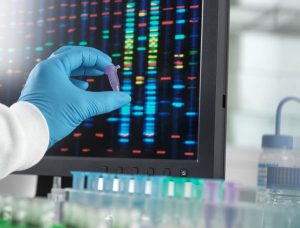
What Is Biomarker Testing for Lung Cancer?
Biomarker testing is the evaluation of samples of a patient’s tumor, blood, or both to identify the genetic mutations responsible for the development of cancer,
HIPAA Alert: Potential Data Breach Learn More
Questions on Oncology, Hematology and/or Infusion Clinical Services due to COVID-19 Crisis – CALL 833-698-1623
Important Information for Our Patients Regarding the Coronavirus.
RCCA Providing Area Cancer Patients with Access to Care During Coronavirus Outbreak
RCCA Offering Patients Virtual Visits During Coronavirus Pandemic
When it comes to cancer, early diagnosis is a person’s best defense. Cancer cannot always be prevented, but early detection offers the best opportunity for successful treatment. Unfortunately, many people avoid the screening tests that can facilitate early identification of cancer due to the perceived inconvenience involved. Thanks to modern diagnostic technology, however, a simple blood test can screen men for prostate cancer.
Here, the medical oncologists of Regional Cancer Care Associates (RCCA), who serve patients at locations throughout New Jersey, Connecticut, Massachusetts, and the Washington, D.C., area, provide important information on the prostate-specific antigen (PSA) blood test used for prostate cancer screening.

Antigens are special markers produced by most types of cells. They are found in viruses, bacteria, parasites, tumors, and even on healthy cells in the body. They are typically made of proteins or sugars and are unique to the type of cell or substance that produces them.
The immune system uses antigens as a type of marker to identify which substances are threats and which are not. When the immune system recognizes an antigen that belongs in the body, called a “self” antigen, it knows to leave the related cells alone. When it detects an unfamiliar or “non-self” antigen, however, it attacks to destroy the intruder cells.
Prostate-specific antigen (PSA) is produced by cells in the prostate gland. While both normal and cancerous prostate cells produce PSA, cancerous cells often produce more. This causes PSA levels to rise when cancer is present, making PSA screening an effective way to recognize the potential presence of cancer.
PSA screening is performed by measuring the amount of PSA present in a sample of blood. Doctors look at blood levels of PSA both to identify potential cancers (PSA screening) and to assess the status of men already diagnosed with prostate cancer (PSA monitoring).
PSA screening cannot detect all forms of prostate cancer because some cancers do not raise PSA levels. It may also return false positives if PSA levels have been impacted by factors unrelated to cancer. In general, however, the blood test is a useful tool for detecting cancer or monitoring its progress. Best of all, the test takes only minutes to complete, making it one of the most convenient ways to check for cancer.
When a patient arrives for PSA screening, a phlebotomy technician will begin by selecting a blood draw site, typically on the patient’s arm. The site will be cleaned with a disinfectant before the technician takes a blood sample. The draw is usually quick and painless, though the patient may feel a slight sting as the needle enters and leaves their arm. Any bleeding is blotted with a cotton swab before a bandage is placed over the draw site.
As with any other blood draw, patients are advised to rest briefly after testing and to drink plenty of liquids. The sample will be sent to a medical laboratory to be tested by a pathologist. Lab results will be returned within a few days or weeks, at which point a follow-up appointment may be scheduled to discuss the results and the next steps.
The PSA level is measured in units called nanograms per milliliter (ng/mL). Higher levels indicate a higher chance of cancer. In general, most men without prostate cancer have PSA levels below four ng/mL. If the PSA level is between four and 10 ng/mL, the patient has a one in four, or 25%, chance of having cancer. If the PSA level is above 10 ng/mL, the chances of cancer rise to 50%.
Although higher PSA levels indicate a higher likelihood of prostate cancer, PSA screening results cannot detect the presence of cancer with absolute certainty. Some cancer types do not affect PSA levels in a significant way. In addition, PSA levels vary between individuals, and there is no concrete threshold that distinguishes between normal and abnormal results. Further, PSA levels may be affected by a variety of factors and conditions unrelated to cancer, including:
As a result, a high PSA reading should not be taken as a sure sign of cancer. Instead, men with elevated levels of PSA should pursue further testing. This will determine the cause of elevated PSA levels, helping the patient make a fully informed decision regarding treatment.
If elevated PSA levels are detected on a screening test, the patient and his healthcare provider will discuss the next steps. This typically involves further testing to confirm the results of the PSA test and to determine what has caused the elevated reading. The typical screening-to-diagnosis process for prostate cancer is as follows:
The first step after detecting an abnormal PSA level is often to schedule a follow-up test, particularly if the patient has no symptoms that would suggest prostate cancer and does not have a strong family history of the disease. The follow-up test may be performed six weeks or more after the original test. The time gap helps physicians determine whether the elevated reading was temporary, and thus likely caused by transient factors, or whether the patient’s PSA level is consistently elevated.
A doctor may also perform a digital rectal exam (DRE) as part of the initial follow-up of an elevated PSA level. During this test, the doctor inserts a gloved finger into the rectum to feel for abnormalities. The test may detect a lump, indicating a tumor. If the DRE does not detect a lump, subsequent PSA tests and DREs may be performed over time to monitor the patient’s condition and ensure that no cancer develops.
If the PSA level is elevated on repeat testing, if a lump is detected during the DRE, or if the physician has other cause for concern, an imaging test may be ordered to look for a tumor. Common imaging tests used for prostate cancer detection include magnetic resonance imaging (MRI), which uses radio waves and strong magnets to create an image, and transrectal ultrasound (TRUS), which employs sound waves to form an image of the prostate and surrounding anatomy
A biopsy is critical for determining the presence of prostate cancer and providing key information on the nature and extent of the disease. This test involves taking a sample of tissue from the prostate. To perform the biopsy, a doctor inserts a thin, hollow needle through the wall of the rectum or through the skin between the anus and the scrotum to remove a small amount of prostate gland tissue. The physician will take several biopsies – usually around 12 – in rapid succession so that pathologists can check different areas of the prostate for cancerous cells.
While the idea of having a biopsy may be daunting, each sample taken typically causes only brief discomfort, and doctors often inject a local anesthetic prior to the biopsy to numb the area. The entire procedure typically takes roughly 10 minutes. Patients often are given an antibiotic both before the biopsy and for a couple of days afterward to reduce the risk of infection. The samples taken are then sent to the laboratory for evaluation. If those samples do show the presence of cancer, pathologists then perform further testing to assess key characteristics of the disease that can influence decisions about which type of treatment is most appropriate.
If you have been diagnosed with prostate cancer, look to the expert medical oncologists of RCCA for comprehensive, compassionate care. RCCA offers the latest prostate cancer therapies at more than 20 locations in New Jersey, Connecticut, Massachusetts, and the Washington, D.C., area. Our specialists have extensive experience in diagnosing and treating a wide variety of cancers and blood disorders. Contact us to learn more or request an appointment.
For more information or to schedule an appointment,
call 844-346-7222. You can also schedule an appointment by calling the RCCA location nearest you.

Biomarker testing is the evaluation of samples of a patient’s tumor, blood, or both to identify the genetic mutations responsible for the development of cancer,

Medical research has made tremendous strides in improving how oncologists understand and treat cancer. One of the most exciting developments is the use of radiopharmaceuticals.

Prostate cancer is a common and fairly complex disease. Though it typically grows very slowly, there are times when prostate cancer can develop suddenly and

Regional Cancer Care Associates is one of fewer than 200 medical practices in the country selected to participate in the Oncology Care Model (OCM); a recent Medicare initiative aimed at improving care coordination and access to and quality of care for Medicare beneficiaries undergoing chemotherapy treatment.